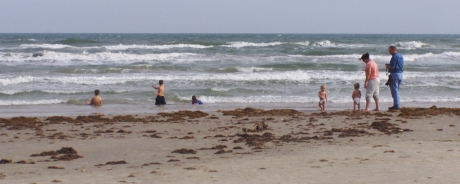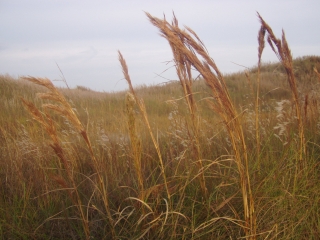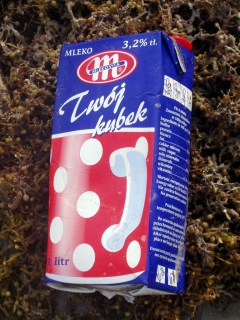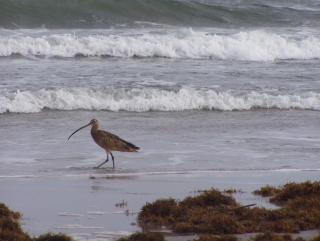near Corpus Christi, Texas
NPS Website; Local Website
A protected 65-mile stretch of Padre Island, the world’s longest barrier island, that offers isolated access to the Gulf of Mexico.
BEAUTY (6/10)
The beach is a beautiful place. Rippling waves, wide horizons, gentle dunes and people having fun. Padre Island NS enjoys unique ecological wonders but suffers from many human incursions.
First, the positive. The Park is a bird watching mecca as is the nearby and non-affiliated Aransas National Wildlife Refuge. Along the beach, we saw snowy plovers, piping plovers, a long-billed curlew, brown pelicans, a roseate spoonbill and so much more; egrets and herons are abundant. Rare hawks and falcons seemed to be perched on every telephone pole during the ride through the Park and to the beach. We novice birders were giddy during our entire visit.
Sadly, there is more to the seashore than unusual birds and superb water. Offshore oil drilling platforms dot the horizon for the extent of the barrier island. Tar is common on the beach, a result of oil spills. Odds bits of litter are everywhere. Milk cartons written in Polish, air conditioners, barnacle-covered sneakers and Portuguese cereal boxes were a few of things we saw. The Visitor Center provides trash bags for those who want to help.
HISTORICAL INTEREST (3/10)
For thousands of years, Native Americans hunted and fished on Padre Island. We have limited knowledge of their history. In 1519, the Spanish explorers charted the island. European settlement did not begin until 1804 when Padre Balli began cattle ranching on the island. In the meantime, the island saw shipwrecks, pirates and more than a few rumors of buried treasure. Ranching continued until the Park was designated a National Seashore in 1962, even during the Island’s short tenure as a World War II naval pilot training facility.
Offshore oil exploration and drilling began around the time Padre Island became part of the National Park System. A clause in the Padre Island NS’s creation documents allows private companies drilling rights to everything below the Park’s surface area. The Sierra Club has recently sued the private companies for breaching their drilling contracts not just as Padre Island NS but also at four other Texas National Park Sites. While we were at Padre Island, there was an article and editorial in the Houston Chronicle about the lawsuit.
 CROWDS (6/10)
CROWDS (6/10)There were a scattered number of people walking arm-in-arm down the beach during our 80º F mid-November visit. There were just enough people to feel a kinship but few enough to believe that you had the beach all to yourself. The massive Malaquite Visitor Center parking lot indicated that things pick up come summer.
Despite the scarcity of cars, Texas drivers still have problems steering their behemoth SUV’s. Even though only about 10 of the 1000+ parking spaces were filled, a woman piloting a Lincoln Navigator tried to squeeze into a spot between a Colorado-plated Honda Accord and our intrepid Altima. She failed and put a huge dent in the Accord’s left rear. After a huge sigh of relief and untold amounts a personal empathy towards the beachcombing Coloradoans, we moved our car away from all traffic.
EASE OF USE/ACCESS (3/5)
The Malaquite Visitor Center is also the National Seashore’s primary beach access. It is located about 25 miles from downtown Corpus Christi. The first 8½ miles of the barrier island are accessible by car along Park Road 22, a continuation of South Padre Island Drive. The remaining 55+ miles of the park are sand. You can drive the entire length of the beach if you have an off-road vehicle.
CONCESSIONS/BOOKSTORE (3/5)
A shopper has two separate stores to enjoy at the Malaquite VC – the official NPS bookstore and a privately owned gift store. The NPS bookstore caters to birders nature lovers, offering posters and charts and of course, books of what you might see on your visit to the Texas coast. Not too much here on the history of the island or on land usage since early habitation.
The gift store caters to your sunscreen and beach going needs – towels, totes, frozen confections and a decent array of Padre Island t-shirts, sweatshirts and shorts can be purchased here. As an added bonus, most of the summer clothing was on sale this late in the season.
 COSTS (3/5)
COSTS (3/5)Park entry is $10 per vehicle, free with the National Parks Pass. If you wish to windsurf, a day-use pass to Bird Island costs $5 but a yearlong pass costs just $10. The Parks Pass does not cover this fee. There are numerous camping options, most of which never fill, ranging from free beach camping ($5 beach permit required) to an $8 a site campground that has toilets and showers. There is no additional cost to off-road along the 55-mile stretch of primitive beach.
RANGER/GUIDE TO TOURIST RATIO (3/5)
One Ranger manned the information desk. Another one popped in and out of a back office and offered his advice on good bird watching areas nearby. Most were outside the Park and required navigation through heavy industrial areas so his advice went unheeded.
The Ranger on-duty was charming, but often on the phone and in no hurry to end his conversation. We went back to the desk after our beach stroll with questions, only to decide they weren’t important enough to wait any longer for his attention. There were few visitors to the Island the morning we were there. An extensive Ranger staff isn’t necessary, but one who is more available to aid visitors would be helpful.
TOURS/CLASSES (6/10)
The Visitor Center advertised twice-daily Ranger talks. We arrived too late to attend either talk, but feel confident that they are a fun experience. The on-duty Ranger charmed us with his joking personality and his thick South Texas drawl. We gingerly laughed through our entire 20-minute conversation not exactly sure of what he was saying but confident that it was funny and helpful. We especially took to heart his baby powder suggestion: it keeps the sand from sticking to your tent and body. He gives the Ranger talks so they must be fun.
The Visitor Center Museum includes a hands-on exhibit with various shells, animal bones and pirate paraphernalia. A number of panels explain the barrier island’s history, geography, wildlife and modern-day usages.
While leaving the park, a number of trucks towing windsurfing equipment passed us. Although unaffiliated with the Park, the Padre Island NS’s website links to a company that gives windsurfing lessons and rents equipment. The website notes that the area is a perfect place to learn how to windsurf. The Laguna Madre on the Park’s west side is home to some of the world’s steadiest breezes. The shallow, warm water is accessible almost year-round at Bird Island Basin and provides some of America’s best windsurfing.
 FUN (8/10)
FUN (8/10)World-class windsurfing, world-class bird watching, surf fishing, 65 miles of structure-less beach and the warm Gulf of Mexico water. Sounds like fun to us.
WOULD WE RECOMMEND? (7/10)
Take note, Padre Island National Seashore is not an infamous spring break destination. That is South Padre Island. South Padre is over 150 miles to the south. If you are looking for raucous fun, Margaritaville-style bars and beachfront condos, it is not here. The National Seashore offers a much more staid and natural kind of fun, the most famous example being the public release of Hawksbill Sea Turtle hatchlings in the Gulf of Mexico. They even provide a hatchling hotline at (361) 949-7163. We had a great time with our binoculars, bird book and our bare feet. You might too.
TOTAL 48/80
www.usa-c2c.com
© 2004-06
